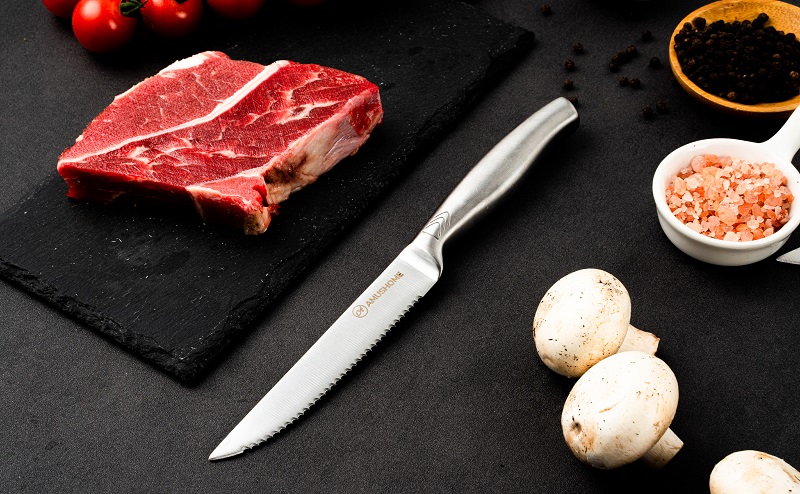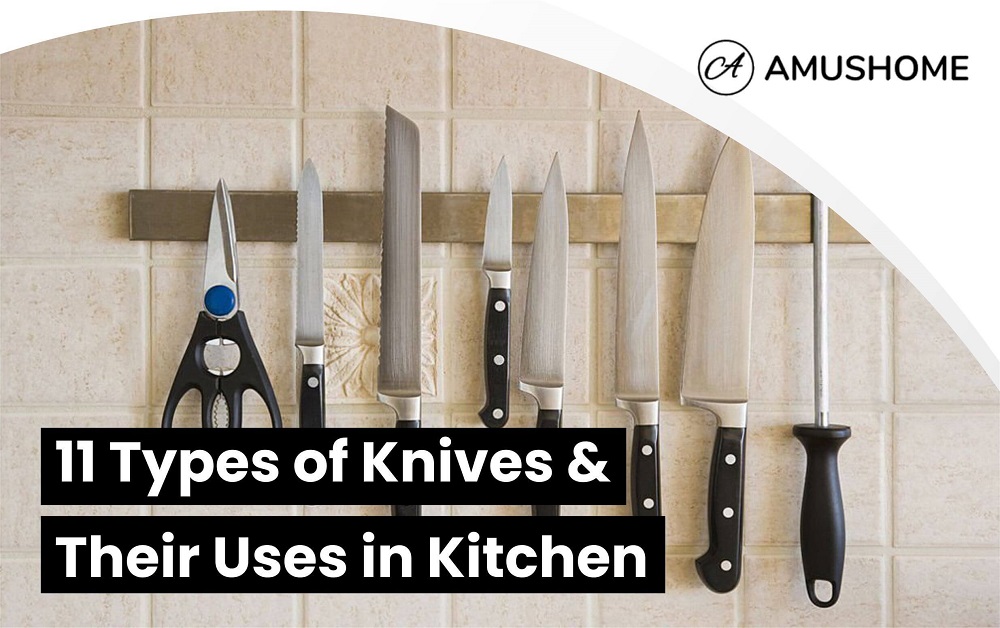When it comes to purchasing knives, it’s important to be familiar with various types of blades to choose the best one for your needs. Here, we have collected some of the most commonly used types of knives that you’ll encounter during your search for the best knife for yourself or others.
This list is not meant to be comprehensive. It is meant as a good starting point for someone who has never purchased a knife before. But first, start our discussion by digging into major categories of kitchen knives.
Two Major Categories of Knife
According to the structure, a knife is divided into two major categories:
| Forged Knife | Stamped Knife |
| A forged knife is made from a single piece of metal. | The stamped knife is made from large, continuous sheets of stainless steel. |
| It uses a powerful press to hammer a steel block, grind, and sharpen. | It is cut into a blade shaped like a cookie-cutter using a powerful embossing machine. |
| A handle is added before applying the final shine and polish to the blade. | The handle is added before sharpening, polishing, and hardening a knife. |
| A forged knife requires a time-consuming and labor-intensive manufacturing process. | The manufacturing process of these knives is cheaper and faster than forged knives. |
| Durable Knives that last for years without needing to be replaced. | Due to their thin steel construction, they tend to be lighter and less durable. |
| The forged knife is easily recognizable by looking for the steel wedge between the blade and the handle. | Knives made this way don’t hold an edge, so you need to sharpen them more often. |
Do You Know? In the past, stamping knives had a bad reputation, but now many brands have refined and improved manufacturing processes to produce stamping knives of quality comparable to forged models.
11 Types of Knives Every Chef Must Know About
- Steak Knife
- Chefs Knife
- Utility Knife
- Bread Knife
- Paring Knife
- Santoku Knife
- Cleaver
- Carving Knife
- Boning Knife
- Fillet Knife
- Nakiri Knife
These all listed are the important types of knives that everyone must have in their kitchen. How are they being used? Find out here!
1. Steak Knife

Steak knives are the only sharp kitchen knives found in modern table settings and are used for slicing steak. These knives mostly have stainless steel blades that are usually about 4 inches long and can be straight or serrated.
Steak knives can be found in various shapes, sizes, and patterned materials, but we like the classic wooden handle of these knives.
If you are a fan of grilling in the backyard, investing in a serrated steak knife from Amushome is worth it.
2. Chefs Knife
The chef can do everything from chopping chicken pieces to chopping large chunks of beef to chopping and slicing vegetables. No other knife is as typical as a professional chef’s knife, also known as a chef’s special or a French knife. Broad and heavy, these knives measure between 6 and 12 inches long and are truly useful.
The chef’s knife blade is forged by hand or stamped using a punching machine. Forged blades are the gold standard when it comes to durability and handling sharp edges.
3. Utility Knife
Although a utility knife is a classic kitchen tool, it isn’t just for cooking. These knives are available in various shapes and sizes, and you can use them to cut, carve, or otherwise process food. This kind of knife will come in handy whenever you need to chop something.
They’re useful for a variety of other tasks, including cutting paper, opening mail, or slicing fruits and vegetables.
Utility knives are a great choice for people who need a knife with a wide range of uses, such as people who like to cook and those who like to spend time outdoors and don’t want to lug around a large chef’s knife everywhere.
4. Bread Knife
Have you recently started a hobby of baking bread? My first bread wasn’t great, but it took me a while to realize that the right bread knife was the real secret to making a fluffy bread look beautiful after the first cut.
These Knives are 6 to 10 inches long and are considered ideal for bread cutting. The serrated edges of the long bread knives are suitable for slicing without crushing the bread so that each piece will be the same height as the next piece. Also, Bread knives maintain their sharpness for up to a year when used solely for slicing bread.
5. Paring Knife
Paring knives, traditionally combined with French chef knives, are made for small, detailed, and complex tasks. Consider peeling the fruit or digging a hole in the pepperoni. I have seen it being used many times for peeling the pepperoni.
This apple knife is 2.5 to 4 inches long, lightweight, easy to operate, and cheap addition to the range of your knives—a great tool to cut fresh fruits and vegetables for garnishing on the dishes.
6. Santoku Knife
Santoku is considered the king of Japanese knives for a reason. It’s only 6 to 7 inches long, slightly shorter than a chef’s knife, but with its super-hardened steel blade, it can handle almost any kitchen task and can hold an edge longer than a Western knife.
These two knives have similar uses, but they are used differently due to the different handle designs, curvatures, and blade angles. Santoku knives are ideal for cutting meat and agricultural products by pulling them directly rather than shaking them to finish the cut.
7. Cleaver
These large, heavy, and rectangular knives are the perfect cutting tool for butchers. Thick blades specially designed for slicing bone add extra weight and strength, allow cooks to “drop” the blades, and facilitate strong amputations of the hands and wrists.
Depending on the country of origin, the cleaver may have different degrees of blade curvature. Chinese-style cleaver has an almost perfectly straight blade, while German-style cleaver usually has a more exaggerated curvature.
I prefer straight Chinese split blades for balance; however, most chefs prefer curved blades as they easily swing on small poultry bones.
8. Carving Knife
Carving knives are longer and thinner than chef knives. As the name implies, these knives are designed to slice meat from large roasts such as turkey and ham.
The thin blades of these knives give you more control over cutting than a Chefs knife. These knives are 8-12 inches long, and little flexibility allows for long accurate cuts. Also, this knife is used for roasting, making it the only knife used for the job.
9. Boning Knife
Boning knives separate meat from the bone, cut fish into fillets, and slice meat. Instead of getting a specific fruit knife, you can also use a small bone-removing knife to peel and trim vegetables and fruits.
Boning knives are typically about 3-8 inches long and have slightly different blade widths. Further, the blade can be flexible, semi-flexible, or rigid. Due to their improved cutting accuracy, rigid blades are most popular among home cooks.
10. Fillet Knife
Fillet knives, another member of the Boning Knife family, are perfect for preparing fish fillets. With a long (6-11 inch), thin and flexible blade, it slides completely under the skin and separates it cleanly from meat.
The pointed blade of the fillet knife turns into a sharp curve in the blade, easily penetrates the fish’s skin, and can be cut smoothly along the length of the meat. Stainless steel is the best metal for fillet knives due to its corrosion resistance.
11. Nakiri Knife
Many kitchen knives are available in Western cuisine, but none is comparable to Japanese nakiri knives. These knives are specially designed for slicing vegetables and are considered one of the unique knives you can add to your kitchen.
It can accurately and decoratively cut fresh items like fruits and vegetables. Nakiri knives are characterized by their thin and light blades, which can cut straight vegetables without pushing or pulling.
FAQs
What types of knives do I need?
The best knife is the one that you can use over and over again. If you are planning a lot of outdoor activities, a folding knife is a perfect tool. While using a fixed blade is better if you will only be doing light tasks around the house.
What types of knives are illegal in the UK?
There are a lot of knives that are illegal in the UK. Some of them include daggers, straight razors, swords, Disguised Knives, Flick knives, butterfly knives, flick knives, etc.
Wind up!
To find the right knife for the job, you’ll need to know what type of job you’ll be doing with it. Will you be chopping, slicing, cutting, or carving?
It’s always important to choose a good knife for the job. Hopefully, the above information will help you pick the right knife.
If you want to learn how to cook at home and develop your skills, a simple knife set includes sharp chef knives and paring knives that can be used for most common cooking projects. If you cut bread regularly, adding a serrated pan knife to your collection will be great.

